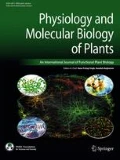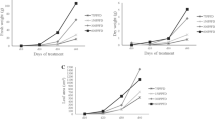Abstract
Growth and physio-biochemical traits under different incident solar light intensities (100, 67, 50 and 25%) were studied in mustard in a semi-arid agroclimate region of Central India. Our comprehensive studies revealed that incident solar light intensities below about 67% were highly detrimental in mustard for its growth and grain yield. Major factors that contributed to the differential responses under varying light intensities were identified which holds importance for better understanding of low light adaptability in an important oilseed crop like mustard. Biomass index (ratio of dry biomass to height) has been established and evaluated for the differential growth performance of the crop under different light intensities. Biomass index progressively declined from 0.48 (open sunlight) to 0.11 (25% sunlight). Physio-biochemical factors were identified that were playing major role in manifestation of the differential growth and grain yield. Mustard exhibited its low light adaptive trends through differential down-regulation in the rates of net CO2 assimilation (PN), stomatal conductance, transpiration, thylakoid electron transport rate (ETR) and leaf wax level. For example, PN decreased from 35.88 (open light) to 11.64 µmol m−2 s−1 (25% sunlight). Photochemical events showed critical impact as evidenced by decreased PSII quantum yield, photochemical quenching (qP) and higher non-photochemical quenching (qN) that were clearly associated with physiological efficiency of the plants under varying light intensities. Leaf wax level decreased from 1.69 mg g−1 fresh weight (open light) to 0.96 mg g−1 fresh weight (25% sunlight). Our results indicated that limited ETR supply across photosystem II (PSII) decreased the photochemical efficiency and carbon gain under low light which resulted in reduction of biomass index and grain yield. Besides, it was found that overexpression of protein band around ~ 26 kDa in low light could be another adaptive feature for mustard related to light harvesting complex. Our findings would augment selection of traits for optimizing growth and grain yield of mustard for low light or light limiting agro-ecosystem.



Similar content being viewed by others
Abbreviations
- Antho.:
-
Anthocyanin
- Chl:
-
Chlorophyll
- ETR:
-
Thylakoid electron transport rate
- E:
-
Transpiration rate
- Gs:
-
Stomatal conductance
- LT:
-
Leaf temperature
- PN :
-
Net CO2 assimilation rate
- PPFD:
-
Photosynthetic photon flux density
- qP:
-
Photochemical quenching
- qN:
-
Non-photochemical quenching
- RH:
-
Relative humidity
- Rubisco:
-
Ribulose bisphosphate carboxylase-oxygenase
- ST:
-
Soil temperature at surface
- SST:
-
Sub soil temperature
- Ta:
-
Air temperature
- ΦPSII :
-
Effective PSII quantum yield
References
Alam B, Nair DB, Jacob J (2005) Low temperature stress modifies the photochemical efficiency of a tropical tree species Hevea brasiliensis: effects of varying concentration of CO2 and photon flux density. Photosynthetica 43:247–252
Alam B, Chaturvedi M, Newaj R (2011) Impact of varying shade on CO2 assimilation, carboxylation efficiency, thylakoid electron transport and water use efficiency in Sesamum indicum L. Range Manag Agrofor 32:79–82
Arnon DI (1949) Copper enzymes isolated chloroplast Polyphenoloxidase in Beta vulgaris. Plant Physiol 24:1–5
Bertamini M, Nedunchezhian N (2002) Leaf pigments, ribulose-1, 5 bisphosphate carboxylase, nitrate reductase and photosynthetic efficiency of grapevine (Vitis vinifera L. cv. Pinot noir) grown under different light conditions. Vitis 41:169–175
Bertamini M, Muthuchelian K, Nedunchezhian N (2006) Shade effect alters leaf pigments and photosynthetic responses in Norway spruce (Picea abies L.) grown under field conditions. Photosynthetica 44:227–234
Bradford MM (1976) A rapid and sensitive for the quantitation of microgram quantities of protein utilizing the principle of protein-dye binding. Anal Biochem 72:248–254
Burkey KO, Wilson RF, Wells R (1997) Effects of canopy on the lipid composition of soybean leaves. Plant Physiol 101:591–598
Evans JR, Poorter H (2001) Photosynthetic acclimation of plants to growth irradiance: the relative importance of specific leaf area and nitrogen partitioning in maximizing carbon gain. Plant, Cell Environ 24:755–767
Genty B, Briantais JM, Baker N (1989) The relationship between the quantum yield of photosynthetic electron transport and quenching of chlorophyll fluorescence. Biochim Biophy Acta 990:87–92
Hastwell GT, Facelli JM (2003) Differing effects of shade induced facilitation on growth and survival during the stablishment of a chenopod shrub. J Ecol 91:941–950
Kho KFE, Bolsman LAC, Vuik JC, Bennink GJH (1977) Anthocyanin synthesis in a white flowering mutant of Petunia hybrid. Plant Physiol 135:109–118
Krause GH, Weis E (1991) Chlorophyll fluorescence and photosynthesis: the basics. Ann Rev Plant Physiol Mol Biol 42:313–349
Laemmli UK (1970) Cleavage of structural proteins during the assembly of the head of bacteriophage T4. Nature 227:680–685
Li H, Jiang D, Wollenweber B, Dai T, Cao W (2010) Effect of shading on morphology, physiology and grain yield of winter wheat. Eur J Agron 33:267–275
Masarovicova E, Elias P (1981) Chlorophyll content in leaves in an oak-hornbeam forest. 2. Shrub species. Photosynthetica 15:16–20
Misra M (1995) Growth, photosynthetic pigment content and oil yield of Pogostemon cablin grown under sun and shade conditions. Biol Plant 37:219–223
Newaj R, Bhargava MK, Shanker AK, Yadav RS, Ajit Rai P (2005) Resource capture and tree crop interaction in Albizia procera based agroforestry system. Arch Agron Soil Sci 51(1):51–68
Osborn JM, Taylor TN (1990) Morphological and ultra-structural studies of plant cuticular membranes. I. Sun and shade leaves of Queracus velutina (Fagaceae). Bot Gaz 151:465–476
Schreiber U, Bilger W, Hormann H, Neuberger C (1998) Chlorophyll fluorescence as a diagnostic tool: basics and some aspects of practical relevance. In: Raghavendra AS (ed) Photosynthesis: a comprehensive treatise. Cambridge University, Cambridge, pp 320–333
Silva Fernandes AMS, Baker EA, Martin JT (1964) Studies on plant cuticle. VI. The isolation and fractionation of cuticular wax. Ann Appl Biol 53:43–58
Singh R, Alam B (2010) Changes in the crop phenology of green gram (Vigna radiata L.) and soybean (Glycine max L. merril.) under varying regimes of shade in a semi-arid agroclimatic location. Indian J Plant Physiol 15:272–277
Singh AK, Kumar P, Singh R, Rathore N (2012) Dynamics of tree-crop interface in relation to their influence on microclimatic changes- a review. HortFlora Res Spectr 1:193–198
Valladares F, Chico J, Aranda I, Balaguer L, Dizengremel P, Manrique E, Dreyer E (2002) The greater seedling high-light tolerance of Quercus robur over Fagus sylvatica is linked to a greater physiological plasticity. Trees Struct Funct 16:395–403
Valladares F, Gianoli E, Gomez JM (2007) Ecological limits to plant phenotypic plasticity—review. New Phytol 176:749–763
Van Kooten O, Snel JFH (1990) The use of chlorophyll fluorescence nomenclature in plant stress physiology. Photosynth Res 25:127–150
Zhang SB, Hu H, Xu K, Li ZR, Yang YP (2007) Flexible and reversible responses to different irradiance levels during photosynthetic acclimation of Cypripedium guttatum. J Plant Physiol 164:611–620
Zhou Y, Singh BR (2004) Effect of light on anthocyanin levels in submerged, harvested cranberry fruit. Biomed Biotechnol 5:259–263
Acknowledgements
All the necessary facilities for the experiments provided by the Director, Indian Council of Agricultural Research (ICAR)-Central Agroforestry Research Institute, Jhansi are greatly acknowledged.
Author information
Authors and Affiliations
Corresponding author
Rights and permissions
About this article
Cite this article
Alam, B., Singh, R., Chaturvedi, M. et al. Determination of critical low light limit and adaptive physiological and biochemical traits regulating growth and yield of mustard (Brassica juncea Coss.). Physiol Mol Biol Plants 24, 985–992 (2018). https://doi.org/10.1007/s12298-018-0537-0
Received:
Revised:
Accepted:
Published:
Issue Date:
DOI: https://doi.org/10.1007/s12298-018-0537-0




